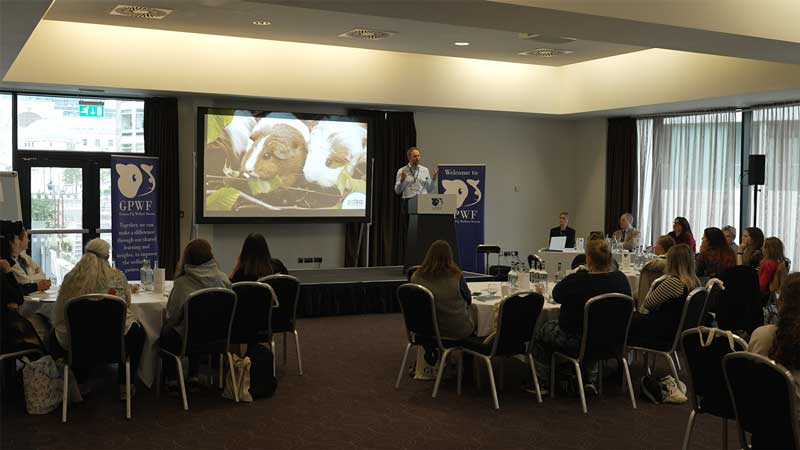8 Apr 2025
John Chitty BVetMed, CertZooMed, MRCVS, reviews the gathering to discuss immediate welfare needs for the cavies, and how relevant issues can be addressed.

Image: galyna0404 / Adobe Stock
In my last article for Vet Times (“Time to think about guinea pigs”; VT54.35), I discussed some of the issues affecting pet guinea pigs and that a Guinea Pig Welfare Forum (sponsored by Burgess Pet Care) was to be held.
This duly took place and drew a range of delegates from across many guinea pig-related areas, including veterinary surgeons and nurses, the pet food industry, pet vending, and breeding and rescue.
In the morning, they were treated to a number of talks from experts in the field on the various guinea pig requirements relating to the five welfare needs, as well as a keynote lecture by Sean Wensley on pet welfare needs and assessment.
The afternoon featured a number of round tables set up for delegates to discuss the talks and establish what they felt were the immediate welfare needs for pet guinea pigs, and how they would address these.
This produced a number of recommendations that can be summarised in the following three categories.
Delegates identified that education was the main key to achieving our aims – an acceptance that most deficiencies in keeping stem from people not knowing what the guinea pigs’ needs are and, from the veterinary side, a lack of teaching on these increasingly common patients.
So, the proposed solutions were:

It was identified that there is a lot we don’t know. This particularly applies to husbandry and diet where there is much opinion, but very little is based on direct reviewed evidence. Following on from the need for more education, it can be more qualified as a need for more education based on results of research and study.
An example used was “how do we know how much space a guinea pig needs?” Discussion very much concluded that guinea pigs were better kept in groups rather than pairs (and must never be kept singly), which fits better with their natural history. However, this requires more space than keeping a pair, which is a limiting factor in people being able to keep such groups.
Research showing how much extra living space a group needs as opposed to a pair may really assist in showing people they can keep more than two, or be a persuader that maybe guinea pigs are not for them.
Diet, it was also felt, needed more research. While we all know about the guinea pig’s vitamin C needs and this has been well studied, little else has been. We are fortunate that there is a growing body of evidence for rabbit diets and it would be good to see this replicated for guinea pigs – we extrapolate a lot, but are guinea pigs that similar to rabbits?
An example is the work showing rabbits’ tolerance of dietary calcium is directly linked to how much they drink – is this the same for guinea pigs?
They have very similar issues with urinary sludge and urolithiasis, but, unlike rabbits, there is currently only circumstantial evidence showing urolithiasis is not directly linked to dietary calcium.
The result of this research and education is, it was felt, to produce a single source of evidence-based recommendations on guinea pig husbandry and medicine for owners, the pet industry and the veterinary profession.
As previously stated, there is a lot of information out there – but much is opinion based and there is a lot of contradiction. While we are always aware there’s never a single, simple answer, too much variability will simply reduce confidence in any information source, as well as encourage further production of information sources. Our aim, therefore, should be to use the evidence we have to produce a go-to information source for all.
In an ideal world, this should also enable feedback, so information quality is monitored and, of course, updated as new information becomes available.

The results from the forum have produced a lot of interest, and we are looking at a number of options to engage this interest and action the proposals from the meeting.
While a number of veterinary organisations were represented at the forum, we are looking to engage the main representative bodies further and increase the amount of exposure of guinea pig needs through the profession.
We also plan to be speaking with Defra and some of our political representatives (the veterinary profession is now well represented in Parliament), and further our ambition to establish welfare guidelines for guinea pigs alongside those for rabbits.
In the shorter term, we will see the long-awaited public launch of the Pet Know-How tool – this is an online learning and assessment tool for prospective pet owners. It has been a joint project by The Pet Charity, BSAVA and BVZS and, with pet industry backing, has the potential to help ensure owners are informed (with expert-led, regularly reviewed education) of pet needs before they buy. Fortunately, guinea pigs will be included in the launch, and we are looking forward to seeing how this progresses.
Better still, plans are at preliminary stage for a second welfare forum, hopefully in the autumn. Watch this space, as there may be some very exciting news of a launch at this event.
If you are keen to be a part of this new journey to improve guinea pig welfare, please contact me via [email protected]